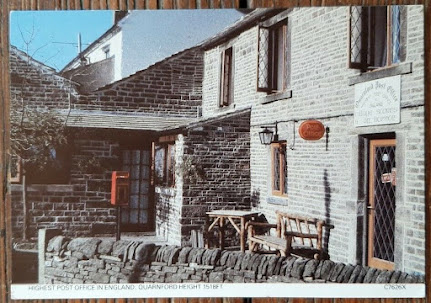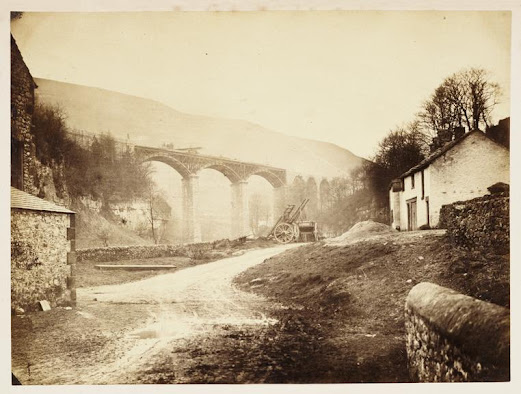We are grateful to Vivian Dubé for the following articles about Derbyshire history:
This Wife for Sale
Between 100 and 200 years ago, husbands all over the country were selling their wives at bargain prices. The going rate was anything from half a pint of beer to 25 guineas (£26.25).
On 5 December 1771 a Derbyshire farmer, Thomas Bott, sold his wife for 1s.6d (7.5p), delivering her up in Derby market place with a halter round her neck. This was an average price at the time.
It was probably a farmer who swapped his wife for a sheepdog and a bale of hay at Chesterfield market.
By comparison, William Bradley of Matlock got gold and silver for his wife of 18 years. In 1773 he sold her at Wirksworth market for two guineas (£2.20p) and a silver watch.
Fifteen years later, again at Wirksworth, a breeches-maker sold his wife to a shoemaker for 5s 3d (26p). About 500 people witnessed the sale, making a great deal of noise as they congratulated the newly-joined couple.
Courtesy of Vivian Dubé; first posted on Facebook 11th July 2022
A New Mills Accident
Accident - The workpeople employed by Messrs, Hibbert and Alcock, Torr Mills, were thrown into a state of alarm on Wednesday morning last, by the sudden stoppage of the machinery, upon inquiring it was discovered that the boiler was fast emptying itself of its contents through the sludge pipe. To avoid a serious accident, it was found necessary to let off the steam and rake out the fire. In the consternation, the stoker who was endeavouring to do his utmost to prevent any damage, accidentally fell off a plank into the boiling water, and was seriously scalded on the back; one of the overlookers hearing his cries for help, went and in attempting to rescue him, accidentally fell in and scalded his legs and feet.
From an undated newspaper cutting
Torr Mill, built in the 1790s stood alongside the River Goyt and just below the Union Road Bridge. The mill was destroyed in a fire in 1912
How Hayfield Bridge Was Built
The handsome bridge over the river in the centre of Hayfield was built in the year 1837, of course, on the site of a more ancient and primitive structure. Cut in the central stone was the inscription:-
"Erected Anno Domini, M.M.C.C.C.X.X.X.V.I.I.
Samuel Worth, Architect.
George Bamford, Builder"
It was a big day when this central stone was laid, in which there is a cavity containing several articles, one of which, it is said, is a bottle of wine. The ancient bridge consisted of three arches, and a former bridge was washed away by a flood 110 years ago. On the 16th June 1858, a great flood occurred caused by an unusual downpour of rain on the top of Kinder Scout, where the water rose to the keystone of the arch, and suddenly the weir, which had stood time out of memory, was torn up, and the back parts of four houses swept away. It was at this flood that Mr Boardman, an old pensioner, who retired to bed early, had to be aroused, and was only got safely away from his bed chamber when the flood swept it away. The bridge is one that the inhabitants may be justly proud of, for the more pressure there is put upon it the firmer it stands. On the south side the arch rests upon solid rock, but great difficulty was experienced in getting a good foundation on the north side, owing to the quicksand which exists on that side of Hayfield. After sinking as deep as possible, bags of wool were pressed down for the foundation. A temporary bridge was made during its erection opposite the George Inn. The new bridge is considerably higher than the old structure, and consequently the road through the village was made much higher, which accounts for some of the houses being so much below the present road level. After the bridge was erected, Mr. George Rowbottom, of Marple, built the Bridge End Buildings (in 1838). Many can well remember the great festivities on the jubilee of the bridge, in 1887.
From an undated newspaper cutting
Hayfield Bridge c1900
The Needhams of Thornsett
Thornsett came to the Needham family by the marriage of Maud, daughter of Roger Mellor, to Thomas de Nedeham, elder son of Thomas, sometime around 1350. She brought with her part of the manor, which at that time was about 1300 acres. Thornsett is a hamlet near Glossop, Derbyshire and is currently in the parish of New Mills, although at the time the Needham's were resident there it was in Glossop parish. Thomas made Thornsett Hall his family residence and subsequently it was the family home of the Needham's for nearly 300 years and 9 generations of the family
Parts of the hall are still visible at Thornsett Hey Farm, notably a stone buttress, visible from the road, just west of the 'Printer's Arms'. A second buttress was demolished some time after the '30s since it was a hazard to traffic. The Thornsett Needham's were Foresters in the Royal Forest of the High Peak , officials acting for the King, and this is reflected in the bucks' heads on the various Needham coats of arms. Needham's of Thornsett are listed among the gentry of Derbyshire from 1360. During the early sixteenth-century, they also acquired the manors of Snitterton and Cowley, and descendants married well into county families. By the time that armorial claims were verified during the Herald's Visitation to Derbyshire in 1611, the family was recognised as Needham of Needham, Thornsett, Snitterton and Cowley.
However, like many good things it didn't last. George Needham (born before 1557), who inherited Thornsett and Cowley from his father William after WIlliams brother Ottiwell died, made some unwise investments in local mines together with his son Henry (born before 1577). This resulted in them selling the family estates ( including Thornsett) in 1613 to Sir Francis Needham of Melbourne Derbyshire, who immediately sold the estates on. Many works indicate that the Seniors of nearby Bridgetown acquired the properties; as a consequence Thornsett left the Needham family. George died in around 1615 and Henry moved to Wales , so by the time of the next Visitation in 1662/3, Needham's were no longer recorded in Derbyshire.
Sources
1. Source : Alastair Lack http://www.lackfamily.net/genealogy/index_genealogy.html
THORNSETT OLD HALL DEMOLISHED - In the interests of public safety this old building known as "Barn End" has been demolished and the road at Thornsett widened. Few people seem to be aware that this old building was once part of one of the historic homes of the old officials of the Ancient Forest of the Peak. Yet this building was the homestead of the Needhams of Thornsett at a time when kings and nobles, knights and ladies, riding across unfenced country, over moorland and waste, through fen and ford, with hooded falcon and stooping hawks enjoyed what was for nearly a thousand years the national sport of England.
Cutting from the Ashton Reporter of 1938


















































